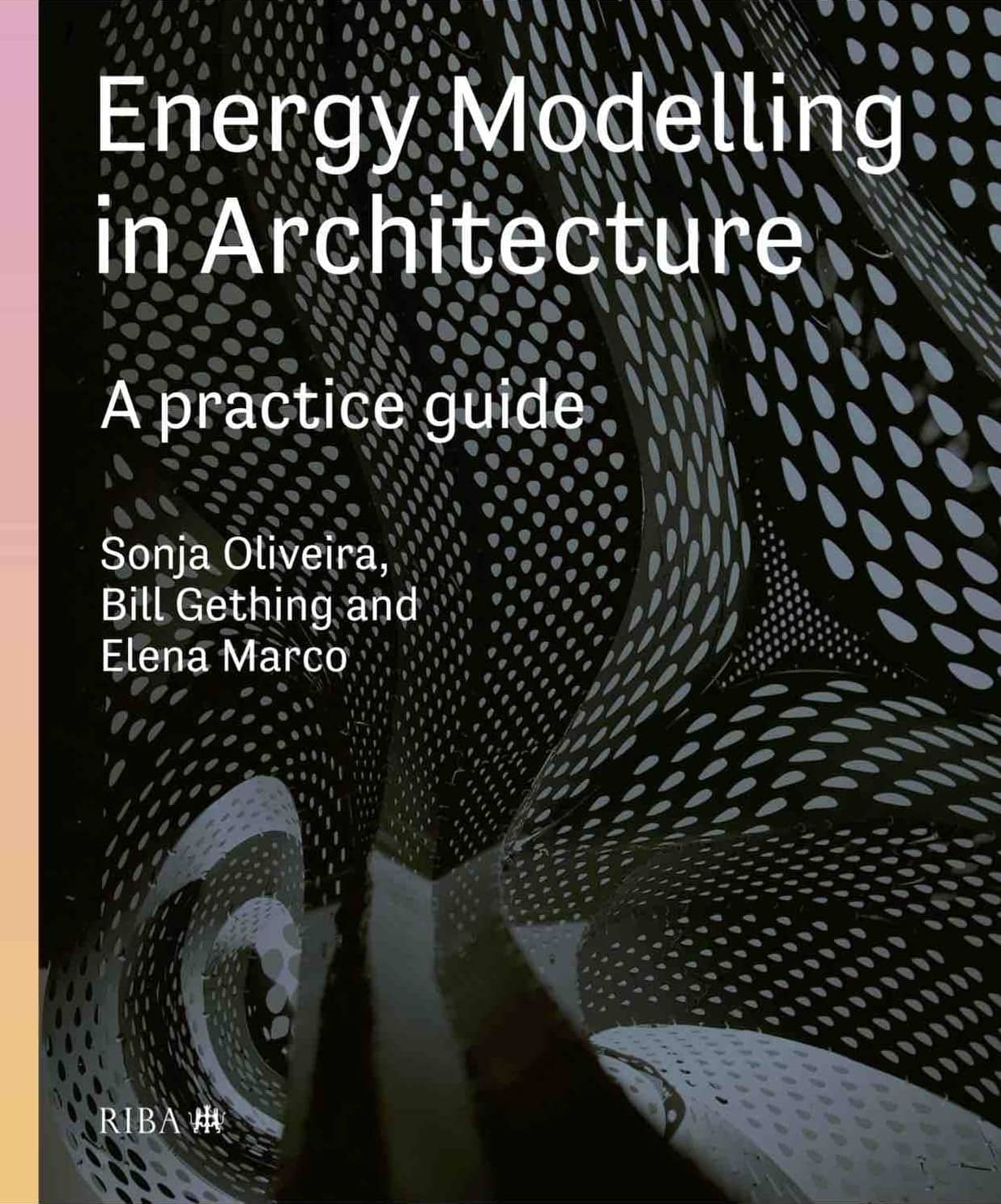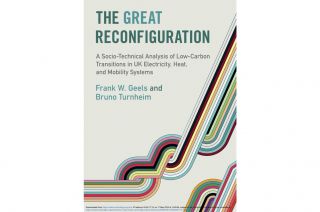
www.buildingsandcities.org/insights/reviews/energy-modelling-in-architecture.html
Energy Modelling in Architecture: A Practice Guide
By Sonja Oliviera, Bill Gething, Elena Marco. RIBA Publishing, 2020, ISBN 9781859469101
Malcolm J Cook reviews this practice guide, which offers a unique insight into the social and organisational challenges facing architectural practices engaged in energy modelling and provides several practical examples. The book is a must read for practitioners, educators and researchers involved in energy modelling, as well as new starters.

Buildings that overheat in summer or waste energy are still too common. We know how to design healthy, low-energy buildings, and have affordable tools and models at our disposal to avoid these problems. In a world where accurate energy prediction of building designs is so important, an appreciation of the concepts and experiences of energy modelling is of fundamental importance. This knowledge should be embedded in appropriate university courses and design practice. This book is aimed at the latter. There are many books available on energy modelling that provide much detail on algorithms, mathematical models and solution techniques. That is not what this book is about. Instead, this book focuses on the social and organisational processes that enable effective energy analysis to be integrated into architectural practice. Through case studies and the experience of practicing architects we learn why this is not straightforward.
The book is a compilation of experiences and viewpoints which avoids a narrowness of views. Compiled by editors who understand practitioners, educators and researchers, it offers a unique insight into the challenges facing architectural practices engaged in energy modelling and their experiences. It embraces the now well-established premise that collaboration is essential. The key to successful low energy design is for architects to work closely with engineers. By considering building performance early in the design process, an effective dialogue is created, offering the important opportunity for all parties to share and understand performance aspirations and co-create appropriate solutions.
The book repeatedly comes back to the benefits of energy modelling and how this has been successfully employed, rather than losing its way in pure architectural design:
'The process of modelling the building … means that designers can drill down into all elements of the building and focus on optimising them in terms of energy and design …'. [p. 76]At the same time, the book, quite rightly, avoids detailed discussions of specific codes and software packages but rather focuses on the purpose (and benefits) of energy modelling. For example, we read how the collective use of different modelling tools:
'enabled the design team to tune the building façade to maximise the energy-saving potential …' [p. 60]
Intelligent use of energy modelling is further exemplified by the authors who propose an energy modelling workflow using goal setting and images to facilitate the communication between members of the design team.
The book's editors offer complementary experiences of architectural practice, education and research. This is evident as the reader turns the pages and observes how the case study materials are presented with a healthy amount of academic rigour that provides the confidence necessary to embrace the ideas presented. Chapter 1 presents the findings from a research study in which interviews and focus group discussions were facilitated with large architecture practices. This enabled a greater understanding of an organisation's approaches to learning how best to use energy modelling tools. The editors also present some interesting insights into university curricula and how interdisciplinary learning, comprising building physics, building services and architecture are key to enabling successful integrated design in practice.
It is insightful to read about the challenges faced by large practices and how these differ to small practices. These challenges include social and organisational leadership and the relationship between the client and the designer. But above all, a collaborative, multi-disciplinary language is key. Many of the contributors highlight the need to understand integration of energy modelling as a socio-technical process in design, not just a technical endeavour. For example, readers are warned about asking:
'questions of energy models that they are simply not intended for' and to understand the 'goal of and claims made about energy models'. [p. 38]
The authors make valuable suggestions such as the benefits of a shared and co-authored energy model that facilitates design iterations, a great means of communication, understanding and shared workflow leading to a so-called new 'shared workflow culture'.
Universities delivering courses in the area of architectural engineering and building services will do well to embrace all these ideas when developing and revising curricula. For example, by promoting inter-disciplinary thinking, collaboration between architects and engineers, and a sound understanding of the role, claims, assumptions and limitations of energy models.
The case studies offer a useful insight into what type and level of energy modelling an architecture practice might consider, bearing in mind the skills of the practice, time available, and what features would have most impact on the final outcome. There are many examples of how to present modelling results in a coherent, meaningful way such that early-stage design questions are answerable with confidence. This is invaluable for architects as it points to the end goal of the modelling exercise, enabling them to ask the right questions of the client and of themselves, gather the appropriate input data and avoid unnecessary simulation.
At appropriate points in the book, the contributors consider what level of modelling accuracy can be expected. When thinking about accuracy, it is important to also think about how and when to monitor real buildings, the role of model validation and the value of data collected via post-occupancy evaluation (POE). All these points are covered in the book, including the latest ideas around submetering and how POE can inform early-stage energy modelling.
The case studies and practitioner accounts offer insights for those who have not yet established an energy modelling capability. The book offers confidence to these stakeholders and points towards the types of tool newcomers to the field might consider. All readers will relate to one or more of the case studies which should fuel their enthusiasm to explore the benefits of energy modelling.
Practitioners will find this book offers useful insights into the subject of energy modelling in architecture. A variety of case studies and experiences make the topic accessible. It covers new build projects but is of equal value for retrofit projects, enabling useful side-by-side comparisons of design options and enabling an understanding of the energy impact of each intervention.
This book is a must read for all architects considering or involved in energy modelling as well as educators responsible for training the generation of designers who will make energy efficient design the norm. For those not involved in modelling, this book provides you with the knowledge you need to ask the right questions, communicate results effectively and design more comfortable, energy efficient buildings.
Latest Peer-Reviewed Journal Content
Designing for pro-environmental behaviour change: the aspiration–reality gap
J Simpson & J Uttley
Lifetimes of demolished buildings in US and European cities
J Berglund-Brown, I Dobie, J Hewitt, C De Wolf & J Ochsendorf
Expanding the framework of urban living labs using grassroots methods
T Ahmed, I Delsante & L Migliavacca
Youth engagement in urban living labs: tools, methods and pedagogies
N Charalambous, C Panayi, C Mady, T Augustinčić & D Berc
Co-creating urban transformation: a stakeholder analysis for Germany’s heat transition
P Heger, C Bieber, M Hendawy & A Shooshtari
Placemaking living lab: creating resilient social and spatial infrastructures
M Dodd, N Madabhushi & R Lees
Church pipe organs: historical tuning records as indoor environmental evidence
B Bingley, A Knight & Y Xing
A framework for 1.5°C-aligned GHG budgets in architecture
G Betti, I Spaar, D Bachmann, A Jerosch-Herold, E Kühner, R Yang, K Avhad & S Sinning
Net zero retrofit of the building stock [editorial]
D Godoy-Shimizu & P Steadman
Co-learning in living labs: nurturing civic agency and resilience
A Belfield
The importance of multi-roles and code-switching in living labs
H Noller & A Tarik
Researchers’ shifting roles in living labs for knowledge co-production
C-C Dobre & G Faldi
Increasing civic resilience in urban living labs: city authorities’ roles
E Alatalo, M Laine & M Kyrönviita
Co-curation as civic practice in community engagement
Z Li, M Sunikka-Blank, R Purohit & F Samuel
Preserving buildings: emission reductions from circular economy strategies in Austria
N Alaux, V Kulmer, J Vogel & A Passer
Urban living labs: relationality between institutions and local circularity
P Palo, M Adelfio, J Lundin & E Brandão
Living labs: epistemic modelling, temporariness and land value
J Clossick, T Khonsari & U Steven
Co-creating interventions to prevent mosquito-borne disease transmission in hospitals
O Sloan Wood, E Lupenza, D M Agnello, J B Knudsen, M Msellem, K L Schiøler & F Saleh
Circularity at the neighbourhood scale: co-creative living lab lessons
J Honsa, A Versele, T Van de Kerckhove & C Piccardo
Positive energy districts and energy communities: how living labs create value
E Malakhatka, O Shafqat, A Sandoff & L Thuvander
Built environment governance and professionalism: the end of laissez-faire (again)
S Foxell
Co-creating justice in housing energy transitions through energy living labs
D Ricci, C Leiwakabessy, S van Wieringen, P de Koning & T Konstantinou
HVAC characterisation of existing Canadian buildings for decarbonisation retrofit identification
J Adebisi & J J McArthur
Simulation and the building performance gap [editorial]
M Donn
Developing criteria for effective building-sector commitments in nationally determined contributions
P Graham, K McFarlane & M Taheri
Join Our Community

The most important part of any journal is our people – readers, authors, reviewers, editorial board members and editors. You are cordially invited to join our community by joining our mailing list. We send out occasional emails about the journal – calls for papers, special issues, events and more.
We will not share your email with third parties. Read more



Latest Commentaries
COP30 Report
Matti Kuittinen (Aalto University) reflects on his experience of attending the 2025 UN Conference of the Parties in Belém, Brazil. The roadmaps and commitments failed to deliver the objectives of the 2025 Paris Agreement. However, 2 countries - Japan and Senegal - announced they are creating roadmaps to decarbonise their buildings. An international group of government ministers put housing on the agenda - specifying the need for reduced carbon and energy use along with affordability, quality and climate resilience.
Building-Related Research: New Context, New Challenges
Raymond J. Cole (University of British Columbia) reflects on the key challenges raised in the 34 commissioned essays for Buildings & Cities 5th anniversary. Not only are key research issues identified, but the consequences of changing contexts for conducting research and tailoring its influence on society are highlighted as key areas of action.